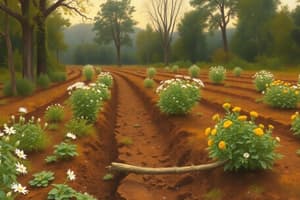Podcast
Questions and Answers
Match the following soil properties with their descriptions:
Match the following soil properties with their descriptions:
Texture = Determined by the amount of sand, silt, and clay in a soil sample Structure = The arrangement of soil particles in the soil itself Porosity = The term for the pore space within an aggregate Chemistry and colour = Physical properties measured by different-sized minerals in a soil sample
Match the following soil particle sizes with their order from largest to smallest:
Match the following soil particle sizes with their order from largest to smallest:
Gravel = Coarse sand Fine sand = Silt Silt = Clay Clay = Humus
Match the following soil analysis techniques with their descriptions:
Match the following soil analysis techniques with their descriptions:
Soil sieve = Used to calculate the percentage of sand, silt, and clay in a soil sample Sedimentation = Another method to calculate the percentage of sand, silt, and clay in a soil sample Soil triangle = Utilized to determine the soil texture based on percentage of sand, silt, and clay Aggregate = When silt, sand, and clay are held together by colloidal particles
Match the following terms related to soil structure with their definitions:
Match the following terms related to soil structure with their definitions:
Match the following soil properties with their effects on the soil:
Match the following soil properties with their effects on the soil:
Match the following soil characteristics with their descriptions:
Match the following soil characteristics with their descriptions:
Match the following soil processes with their explanations:
Match the following soil processes with their explanations:
Match the following soil water characteristics with their effects:
Match the following soil water characteristics with their effects:
Match the following soil improvement methods with their effects:
Match the following soil improvement methods with their effects:
Match the following soil components with their characteristics:
Match the following soil components with their characteristics:
Flashcards are hidden until you start studying
Study Notes
Soil Properties and Characteristics
- Soil properties are matched with their descriptions
- Properties include texture, structure, and others that affect soil behavior
Soil Particle Sizes
- Particle sizes are ordered from largest to smallest
- Sizes include sands, silts, and clays, each with distinct characteristics
Soil Analysis Techniques
- Techniques are used to determine soil properties and characteristics
- Examples include laboratory testing and field observation
Soil Structure
- Terms related to soil structure are defined
- Structure affects soil's ability to support plant growth and resist erosion
Soil Properties and Effects
- Soil properties have significant effects on the soil
- Examples include water infiltration, aeration, and nutrient availability
Soil Characteristics
- Soil characteristics are described and classified
- Characteristics include pH, temperature, and salinity
Soil Processes
- Soil processes are explained and their importance discussed
- Examples include weathering, erosion, and nutrient cycling
Soil Water Characteristics
- Soil water characteristics affect soil behavior and plant growth
- Examples include water holding capacity, infiltration rate, and water table
Soil Improvement Methods
- Methods are used to improve soil properties and fertility
- Examples include fertilization, irrigation, and tillage
Soil Components
- Soil components are characterized and their roles explained
- Components include organic matter, minerals, and living organisms
Studying That Suits You
Use AI to generate personalized quizzes and flashcards to suit your learning preferences.




